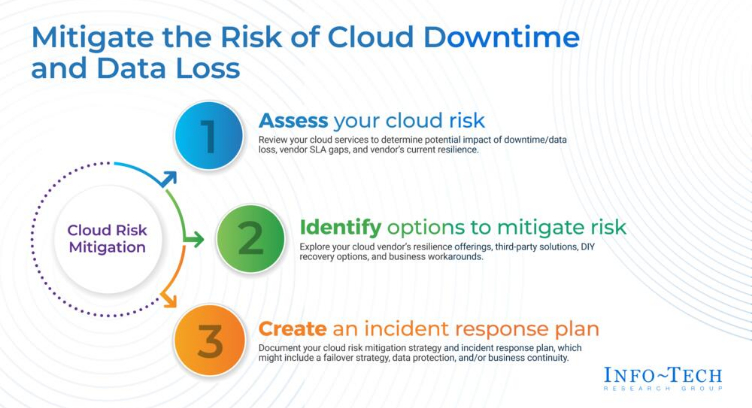Info-Tech Research Group, a global IT research and advisory firm, has published a new data-backed blueprint, Mitigate the Risk of Cloud Downtime and Data Loss, to help IT leaders enhance resiliency and disaster recovery strategies in an increasingly cloud-based and Software-as-a-Service (SaaS) focused world.
As outlined in Info-Tech's latest industry resource, with organizations increasingly migrating applications to cloud-based services, they must take action in developing disaster recovery and business continuity plans that account for potential cloud risks and include strategies for mitigating them. When building these plans, organizations must also assess the reliability and resilience of cloud vendors and their services, security measures, data protection capabilities, and contingency plans for technology and business operations in the event of a cloud outage or incident.
Migrating to cloud services transfers the responsibility of day-to-day platform maintenance to IT leaders, who must also address senior leadership concerns about dependency on third-party cloud services and the associated risks.
The firm's resource highlights the challenges IT leaders often face when managing the cloud, including their limited control over third-party incidents that can restrict recovery or continuity options, particularly for SaaS services. While some vendors offer resilience options for common SaaS solutions, this is not always the case for all cloud services. A key part of addressing this problem involves defining business process workarounds that require cooperation from business leaders.
Info-Tech advises a practical approach for IT leaders to overcome cloud-related challenges, which must be adapted for downtime and data loss risks, especially when working with SaaS solutions that offer limited or no control over the system. Even with limited control, IT leaders can still define an incident response plan to streamline the process of notification, assessment, and implementation of workarounds.
For IT leaders working to mitigate cloud services risk, the firm recommends the following three actions:
1. Assess the cloud risk: Review the cloud services to determine the potential impact of downtime/data loss, vendor SLA gaps, and the vendor's current resilience.
2. Identify options to mitigate risk: Explore the cloud vendor's resilience offerings, third-party solutions, DIY recovery options, and business workarounds.
3. Create an incident response plan: Document the cloud risk mitigation strategy and incident response plan, including a failover strategy, data protection, and business continuity.
The blueprint encourages IT leaders to inquire about their cloud vendor's disaster recovery and business continuity plans, as well as resiliency capabilities. It's also essential to ask about additional offerings or recommendations to boost cloud service resilience and assess potential risks. By doing so, leaders can help organizations protect against unexpected disruptions and ensure seamless cloud service performance.
Frank Trovato, advisory director at Info-Tech Research Group
The key to developing an effective cloud strategy is to recognize what can be controlled and what actions can be taken to evaluate and mitigate risk. At a minimum, IT leaders can ensure senior leadership is aware of the risk and define a plan for responding to an incident, even if it is limited to monitoring and communicating status.





















